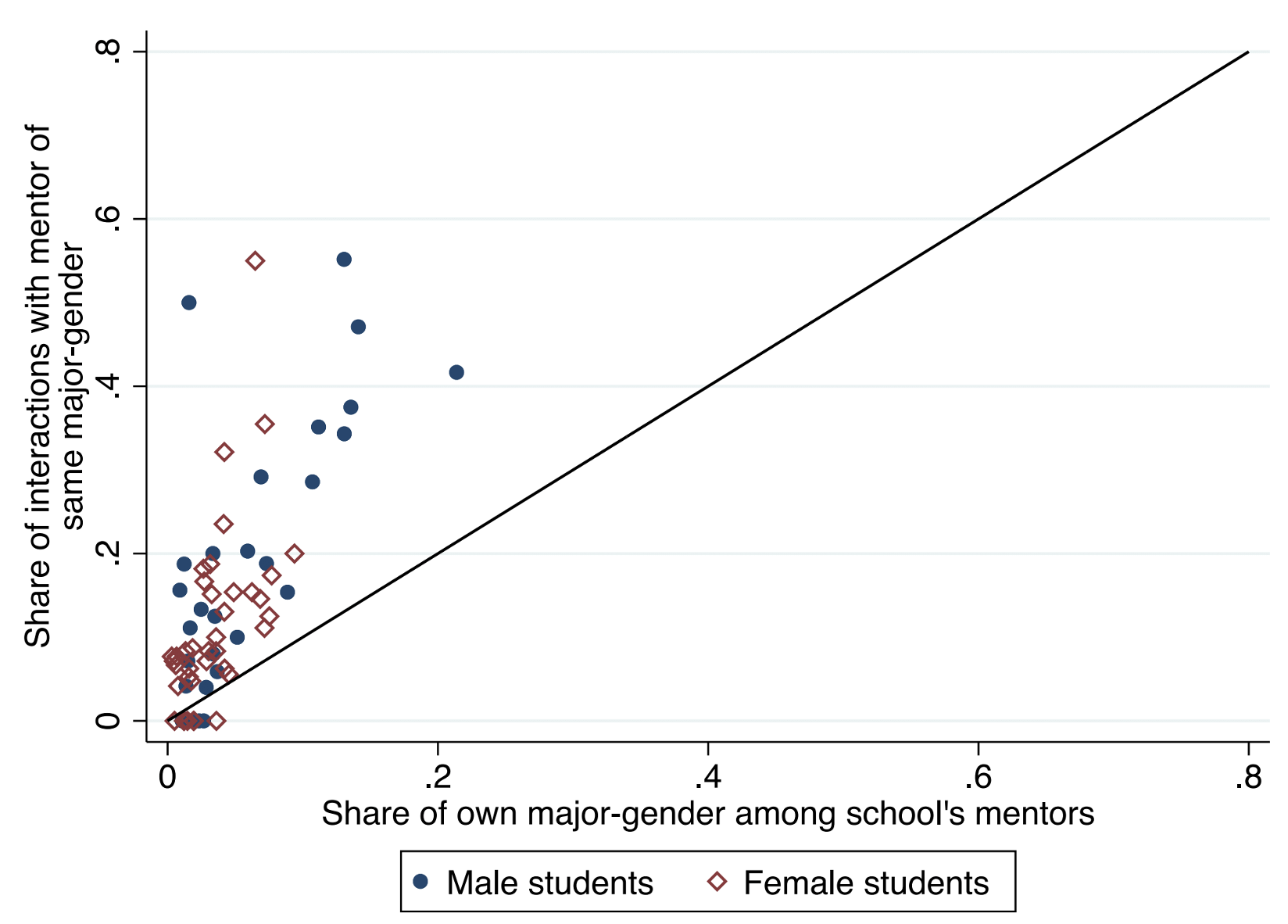Mentorship is a setting – unlike hiring or lending or renting – in which explicitly using race, gender, and nationality to determine matches is common, encouraged, and even considered best practice. Nearly all top universities have mentorship programmes for women in STEM fields, and 80% of the programmes match students with a same-gender mentor. These female mentorship programmes are often used to address the exit of women from STEM fields (Hunt 2010). But do female mentees value same-gender mentors?
Using novel administrative data from an online student/alumni mentoring platform serving eight colleges and universities, we document substantial homophily – the tendency to associate with people like oneself – in student-alumni interactions (Gallen and Wasserman 2022). Figure 1 characterises homophily by gender, plotting the fraction of interactions on the site that occur between students and alumni who share the student’s gender and major against the availability of same gender-major alumni on the platform. The solid 45 degree line depicts the composition of student-alumni interactions that we would expect if students messaged alumni at random on the platform. The fraction of same-gender/major interactions on the site is higher than what would be expected by chance at almost all of the universities. When we control for characteristics such as student major, alumni major, and alumni occupation, we find that female students are 36% more likely to reach out to female mentors relative to male students.
Figure 1 Homophily in an online mentoring platform
Note: This figure uses data from eight universities/colleges to plot the share of messages initiated by students that were sent to an alumni with a shared trait. The left panel analyses the fraction of conversations with a same-gender alumni, and the right panel examines the fraction of conversations with a same-gender and same-major alumni.
These same-gender pairings could be beneficial interactions, as suggested by previous research on students and teachers, advisees and advisors, and patients and physicians (Carrell et al. 2010, Canaan and Mouganie 2021, Cabral and Dillender 2021). In this setting, however, the propensity to reach out to female mentors may come at a cost: female mentors are 12% less likely than male mentors to respond to messages sent by female students. We also don’t find evidence of positive effects on the length of reply (conditional on reply).
Why are students making these trade-offs? One possibility is that female mentors provide better mentorship for female mentees. Another possibility is that female students use gender as a proxy for mentor quality when they have no direct information about quality, but do not value mentor gender per se.
To better understand whether and why female students make trade-offs to access female mentors, we conducted a survey of 834 University of California, Los Angeles (UCLA) undergraduates. Survey participants were presented with 30 pairs of hypothetical mentors and asked which mentor they preferred in each pair. Each mentor profile had the mentor’s first name – which unambiguously conveyed their gender – their job title, how much time they could devote to mentorship, the year they graduated, and whether they were a first-generation university graduate. To incentivise students to tell the truth, we informed students that their survey responses would be used to generate personalised advice regarding how to find mentors.
Our survey allows us to isolate the preference for mentor gender, distinct from other mentor attributes. We are also able to observe all of the information on mentors that is available to students, which is not feasible in the mentorship platform data.
We find that female students strongly prefer female mentors, while male students exhibit a weak preference for male mentors. In fact, using the trade-offs that students make during the survey, we estimate that female students are willing to give up a mentor with their preferred occupation 28% of the time in order to access a female mentor.
But does this preference for female mentors arise from a lack of information on mentor quality? To answer this question, we randomised half of the students to see basic profiles, with only the information listed above. The other half of the students were randomised to see profiles with basic information plus star ratings from a past mentee of three mentor qualities: knowledge about job opportunities, friendliness, and capacity to give personalised advice. Figure 2 provides an example of a pair of profiles with ratings.
Figure 2 Example of mentor profiles
Note: This figure is a screenshot of a pair of profiles shown in the hypothetical choice-preference elicitation survey administered among UCLA undergraduates. The profiles are from the survey version with mentor ratings. The survey version without ratings omits the box below each profile.
We find that female students are willing to pay for female mentors only when there is no information on mentor quality. When students see the basic profiles, female students are willing to trade-off a mentor with their preferred occupation to access a female mentor. When students see the profiles with ratings, we find that this willingness to pay declines to zero. In other words, when information on mentor quality is available, female students are unwilling to trade-off any dimension of mentor quality to access a female mentor. Female students would rather have a mentor of a different gender than sacrifice mentor quality.
We also explore whether the gender of the person providing information on mentor quality matters. Does the rating of past mentee ‘Alexa’ carry more weight than the rating of past mentee ‘Alex’ for female students? We find that the gender of the past mentee does not matter. These results suggest that female students do not require another woman to vouch for a mentor prior to mentor selection.
Why do female students value mentor gender when information on mentor quality is scarce? When we ask students why they value mentor gender, female students say that female mentors are more friendly/approachable than male mentors and are also better at giving personalised advice. In the absence of information on these qualities, female students use mentor gender as a proxy for these qualities. This work reveals that gender is valued for its information content, and that direct provision of that information would reduce students’ valuations of a mentor’s gender.
More broadly, this research cautions that using shared traits in initiatives such as employee recruitment, service-provider matching, and doctor-patient matching could lead to efficiency losses relative to incorporating information on valued traits into the matching process. For example, rather than offer same-gender matching, ride-sharing platforms have opted to inform riders that their driver has been background checked. Finally, since matching on shared traits often occurs in settings where individuals with the trait are scarce, an additional benefit of shifting to matching based on quality metrics is that it would alleviate the time burden of these initiatives on already underrepresented groups (Babcock et al. 2017).
References
Babcock, L, M P Recalde, L Vesterlund and L Weingart (2017), “Gender Differences in Accepting and Receiving Requests for Tasks with Low Promotability”, American Economic Review 107(3): 714–47.
Cabral, M and M Dillender (2021), “Gender Differences in Medical Evaluations: Evidence from Randomly Assigned Doctors”, working paper.
Canaan, S and P Mouganie (2021), “The Impact of Advisor Gender on Female Students’ STEM Enrollment and Persistence”, Journal of Human Resources.
Carrell, S E, M E Page and J E West (2010), “Sex and Science: How Professor Gender Perpetuates the Gender Gap”, The Quarterly Journal of Economics 125(3): 1101–1144.
Gallen, Y and M Wasserman (2022), “Does Information Affect Homophily?”, IZA DP No. 15362.
Hunt, J (2010), “Why do women leave science and engineering?”, VoxEU.org, 22 May.





